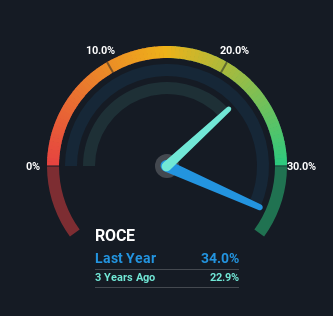Stock Analysis
Here's What Fine Organic Industries' (NSE:FINEORG) Strong Returns On Capital Mean

If you're not sure where to start when looking for the next multi-bagger, there are a few key trends you should keep an eye out for. Firstly, we'll want to see a proven return on capital employed (ROCE) that is increasing, and secondly, an expanding base of capital employed. If you see this, it typically means it's a company with a great business model and plenty of profitable reinvestment opportunities. That's why when we briefly looked at Fine Organic Industries' (NSE:FINEORG) ROCE trend, we were very happy with what we saw.
Return On Capital Employed (ROCE): What Is It?
For those who don't know, ROCE is a measure of a company's yearly pre-tax profit (its return), relative to the capital employed in the business. The formula for this calculation on Fine Organic Industries is:
Return on Capital Employed = Earnings Before Interest and Tax (EBIT) ÷ (Total Assets - Current Liabilities)
0.34 = ₹5.8b ÷ (₹19b - ₹1.5b) (Based on the trailing twelve months to September 2023).
Therefore, Fine Organic Industries has an ROCE of 34%. That's a fantastic return and not only that, it outpaces the average of 14% earned by companies in a similar industry.
View our latest analysis for Fine Organic Industries

Above you can see how the current ROCE for Fine Organic Industries compares to its prior returns on capital, but there's only so much you can tell from the past. If you'd like, you can check out the forecasts from the analysts covering Fine Organic Industries here for free.
What Can We Tell From Fine Organic Industries' ROCE Trend?
In terms of Fine Organic Industries' history of ROCE, it's quite impressive. Over the past five years, ROCE has remained relatively flat at around 34% and the business has deployed 246% more capital into its operations. Returns like this are the envy of most businesses and given it has repeatedly reinvested at these rates, that's even better. If these trends can continue, it wouldn't surprise us if the company became a multi-bagger.
One more thing to note, even though ROCE has remained relatively flat over the last five years, the reduction in current liabilities to 7.9% of total assets, is good to see from a business owner's perspective. This can eliminate some of the risks inherent in the operations because the business has less outstanding obligations to their suppliers and or short-term creditors than they did previously.
The Key Takeaway
In the end, the company has proven it can reinvest it's capital at high rates of returns, which you'll remember is a trait of a multi-bagger. And long term investors would be thrilled with the 313% return they've received over the last five years. So even though the stock might be more "expensive" than it was before, we think the strong fundamentals warrant this stock for further research.
While Fine Organic Industries looks impressive, no company is worth an infinite price. The intrinsic value infographic in our free research report helps visualize whether FINEORG is currently trading for a fair price.
If you'd like to see other companies earning high returns, check out our free list of companies earning high returns with solid balance sheets here.
Valuation is complex, but we're helping make it simple.
Find out whether Fine Organic Industries is potentially over or undervalued by checking out our comprehensive analysis, which includes fair value estimates, risks and warnings, dividends, insider transactions and financial health.
View the Free AnalysisHave feedback on this article? Concerned about the content? Get in touch with us directly. Alternatively, email editorial-team (at) simplywallst.com.
This article by Simply Wall St is general in nature. We provide commentary based on historical data and analyst forecasts only using an unbiased methodology and our articles are not intended to be financial advice. It does not constitute a recommendation to buy or sell any stock, and does not take account of your objectives, or your financial situation. We aim to bring you long-term focused analysis driven by fundamental data. Note that our analysis may not factor in the latest price-sensitive company announcements or qualitative material. Simply Wall St has no position in any stocks mentioned.
About NSEI:FINEORG
Fine Organic Industries
Fine Organic Industries Limited engages in manufacture, processing, supply, distribution, and import of oleochemical-based additives in India and internationally.
Flawless balance sheet with proven track record.

